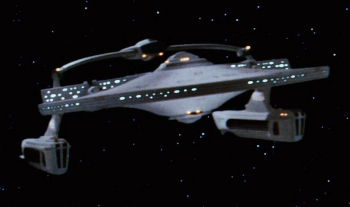

I decided to try out the shipbuilding rules for Star Trek Adventures. The mechanics are similar to the Lifepath PC build option, which was quite a relief to me. While I have done a few D6 to FFG Star Wars vehicle conversions, I found those very hard to do, but this system is so much like character creation, it was a breeze comparatively. So join me in dry dock to watch the latest refit–step by step–of the U.S.S. Hadfield. (All page references are for the STA core book.) This Miranda-class vessel was named for the Canadian astronaut Chris Hadfield, a really cool guy that I admire a lot.
Ships in STA have Scale, Systems, Departments, Traits, and Talents. The last 2 work the same as the character mechanics, although ships have different Traits and Talents. Like Lifepath, there are several steps to ship creation: Service, Spaceframe, Mission Profile, Refits, and Putting It All Together.
1. Service: The year the campaign starts, which your group should have already agreed on. Since Hadfield is not being used in a specific campaign, I decided on 2295, a time a friend suggested because it is “‘off the main road’ for canon…[and] you have lots of room to play around in.”
2. Spaceframe: The starship’s class. The class sets the ship’s Scale, Weapons, base Systems scores, 3 points towards Departments, and possibly some Talents. It will also include the year the class enters service. Choices are Akira-, Constellation-, Constitution-, Defiant-, Excelsior-, Galaxy-, Intrepid-, Miranda-, and Nova-class.
I selected the Miranda-class, which is pretty versatile and provides the following base stats:
Entered Service: 2274
Scale: 4
Systems: Comms 8, Computers 8, Engines 8, Sensors 9, Structure 8, Weapons 9.
Departments: Command +1, Conn +1, Security –, Engineering –, Science +1, Medicine —
Weapons: Phaser Banks, Photon Torpedoes, Tractor Beam (strength 3)
Talent: Extensive Shuttlebays
3. Mission Profile: This step increases the Department scores generated in the previous step, plus adds 1 Talent out of a list of 3-5. Choice of Strategic & Diplomatic (flagships, battlegroups); Pathfinder & Reconnaissance (very long range, remote); Technical Test-bed (prototype tech); Tactical Operations (defense, police actions); Science & Survey; Crisis & Emergency Response; or Multirole Explorer.
I picked Multirole Explorer, as the most flexible, since I don’t have a particular cmpaign style in mind. Multirole adds 2 to each Department score, upping them to:
Command +3, Conn +3, Security +2, Engineering +2, Science +3, Medicine +2
Multirole gives me 5 Talent options, and I pick what I think will be most useful in the most situations–Rugged Design, to reduce Repair difficulties.
4. Refits: For every full decade a vessel is in service, it gets 1 refit, which adds +1 to a single System. Subract the year the vessel entered service (from Spaceframe step) from the start of the campaign (Service step).
For the Hadfield, 2295 – 2274 = 21 years, so 2 refits. I decide on increasing Engines and Sensors: Engines 9, Sensors 10
5. Putting It All Together
Traits: Every Starfleet vessel gets the Federation Starship trait. Players and GM can agree on additional traits, and there are several suggested.
I stuck with just Federation Starship for simplicity’s sake.
Systems: While vessels may have scores of 12+ *before any refits*, they cannot become 12+ due to refits. No score can be increased by more than 2 due to refits.
Hadfield‘s highest Systems scores are within the limits.
Departments: Class + Mission Profile scores.
I did this in Step 3.
Scale: Per Class.
Miranda-class Scale = 4
# of Talents: Equal to Scale.
Hadfield already has Extensive Shuttlebays and Rugged Design from its Class and Mission Profile, respectively, so needs 2 more. I pick Advanced Sensor Suites–to help out on survey missions–and Backup EPS Conduits–to lessen chances of power loss in emergencies.
Weapons: Per Class. Energy Weapon Damage = Scale + Security + weapon type factors. Torpedo Damage = Base Torpedo Damage + Security.
The Hadfield‘s Phaser Banks do 4 + 2 + 1 = 7 Damage, with Versatile 2 quality. The Proton Torpedoes do 3 base damage with High Yield quality.
Derived Stats: Resistance = Scale; Shields = Structure + Security; Power = Engines; Crew Support = Scale. Some Starship or Character Talents may modify any of these.
Derived Stats for the Hadfield are:
Resistance 4, Shields 10, Power 9, Crew Support 4
Name and Designation: The STA core book gives guidelines for names and alphanumeric designation.
Namesake for this ship is an historical figure, an old Earth Astronaut. Since it’s not a prototype or the first vessel of the class, its designation is NCC-2901. I just picked the digits and did a quick check on the Memory Alpha website to see if it had been used, because I am detail-oriented.
Using the Hadfield in other campaigns: To use the Hadfield in campaigns starting in other years, figure out the number of refits it would gain/lose in your timeframe and add to whichever System score/s you wish, following the limits above in Step 5, or–for pre-2294 campaigns–set Engines to 8 and/or Sensors to 9. That’s it! Just don’t let those humorless Department of Temporal Investigations martinets catch you at it!
U.S.S. HADFIELD, NCC-2901
SERVICE DATE 2274 SPACEFRAME: Miranda-class
MISSION PROFILE: Multirole REFIT: 2x
SYSTEMS
Engines 9 Computers 8 Weapons 9
Structure 8 Sensors 10 Communications 8
DEPARTMENTS
Command 3 Security 2 Science 3
Conn 3 Engineering 2 Medicine 2
TALENTS
Extensive Shuttlebays (p. 256)
Rugged Design (p. 257)
Advanced Sensor Suites (p. 255)
Backup EPS Conduits (p. 255)
WEAPONS
Phaser Banks: 7 Damage, Versatile 2.
Proton Torpedoes: 3 base Damage, High Yield
Tractor Beam: Strength 3
SCALE 4 POWER 9 SHIELDS 10 CREW SUPPORT 4
Credit: Thanks to Empty Bacta Tank for beta-reading and feedback.
